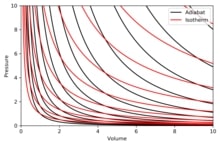This article discusses in detail about the adiabatic example that means examples of adiabatic process. An adiabatic process is one of the many important thermodynamic processes.
The term adiabatic means no heat and mass transfer. In an adiabatic process, no heat or mass transfer takes place across the walls or boundary of system.
What is an adiabatic process?
An adiabatic process is a type of thermodynamic process in which there is no heat and mass transfer between the system and its surroundings that is no amount heat or mass can exit or enter the system.
The energy transfer from an adiabatic system takes place in the form of work done. Transfer of heat is prohibited by the adiabatic walls of system. The working fluid inside the system can perform work by moving the walls of system to and fro or up and down. For example piston.
Mathematically, an adiabatic process can be represented as-
Del Q= 0 and Del m = 0
Where Q represents heat transfer
And
m represents mass transfer
What is work done in adiabatic process?
Few parameters are required to calculate the work done in adiabatic process. These parameters are specific ratio, start and end temperatures of the process or start and end pressure values of the process.
Mathematically,
Work done in adiabatic system is given by-
W = R/1-γ x (T2 – T1)
Where,
Y is the specific heat ratio
R is the universal gas constant
T1 is the temperature before the start of adiabatic process
T2 represents temperature after completion of adiabatic process
Applications of adiabatic assumptions
First law of thermodynamics for a closed system can be written as, dU=Q-W. Where, U is the internal energy of the system, Q is the heat transfer and W is the work done by the system or on the system.
- If system has rigid walls, volume cannot be changed hence W=0. And the walls are not adiabatic, then the energy is added in terms of heat such that temperature rises.
- If system has rigid walls such that pressure and volume does not change, then the system may undergo isochoric process for energy transfer. In this case also, the temperature rises.
- If system has adiabatic walls and rigid walls, then the energy is added in non viscous, frictionless pressue volume work where no phase change takes place and only temperature rises, this is termed as isentropic process (or constant entropy process). It is an ideal process or reversible process.
- If the walls are non adiabatic then heat transfer takes place. This results in increase in randomness of the system or entropy of the system.
Example of adiabatic processes
The temperature of gas increases when adiabatic compression takes place and temperature of the gas decreases when adiabatic expansion takes place.
Detailed discussion is given about adiabatic cooling and adiabatic heating in below section.
Adiabatic cooling– When the pressure of an adiabatic isolated system is decreased, the gas expands causing the gas to do work on surroundings. This results in decrease in temperature. This phenomenon is responsible for formation of lenticular clouds in the sky.

Adiabatic heating- When work is done on an adiabatic isolated system, the pressure of the system increases and hence the temperature increases. Adiabatic heating finds its applications in diesel engine during the compression stroke to increase the fuel vapour temperature enough to ignite it.

Example of adiabatic compression
Lets assume data of gasoline engine during its compression stroke as-
Uncompressed volume of cylinder- 1 L
Specific heat ratio-7/5
Compression ratio of engine- 10:1
Temperature of uncompressed gas- 300K
Pressure of uncompressed gas- 100kpa
Calculate the final temperature after adiabatic compression.
The solution to above problem can be given as-
P1V1γ = C = 6.31Pa.m.21/5
Also,
P2V2γ = C = 6.31Pa.m.21/5 = P x (0.0001m3)7/5
So the final temperature can be found using equation given below-
T = PV/constant = 2.51 x 106 x 10-4m3/0.333Pa.m3K-1
Plotting adiabats
Adiabat is the curve of constant entropy on P-V diagram. Y axis denotes pressure, P and X axis denotes volume, V.
- Similar to isotherms, adiabats also approaches P and V axis asymptotically.
- Each isotherm and adiabat intersect once.
- Both isotherm and adiabat look similar except during free expansion where an adiabat has steeper inclination.
- Adiabats are towards east North-east if Isotherms are towards North-east direction.
The adiabats can be shown in the diagram below-

Image credits: AugPi, Entropyandtemp, CC BY-SA 3.0
Red curves represents Isotherms and black curve represents adiabats.
Examples of adiabatic processes in industry
There are several places where adiabatic process can take place. The examples of adiabatic process are as given below-
- Releasing of air from a pneumatic tire is an example of gas compression with heat generation.

- Nozzles, compressors, and turbines use adiabatic efficiency for their design. This can be considered as the most imortant applications of adiabatic process.
- Oscillating pendulum in a vertical plane is a perfect example of adiabatic process.

- Quantum harmonic oscillator is also an example of adiabatic process or system.
- Icebox prevents heat to enter or exit from the system. This is also an example of adiabatic system.
Difference between isothermal and adiabatic process
The difference between isothermal process and adiabatic process is given below-
| Isothermal process | Adiabatic process |
| Isothermal process is a process in which the temperature of the system does not change. The entire process takes place at a constant temperature. | Adiabatic process is a thermodynamic process in which no heat transfer takes place between system and surroundings meaning there is no exchange of heat across the walls of system. |
| Work done is because of net heat transfer in the system. | Work done is because of net internal energy change inside the system. |
| Temperature cannot be changed. | Temperature can be variable in adiabatic process. |
| Heat transfer can take place. | Heat transfer cannot take place. |
What happens when a cylinder containing high pressure gas explodes?
Whenever a cylinder containing gas high pressure gas expodes. The undergoes two types of changes. They are-
- Irreversible adiabatic change.
- Temperature of the gas decreases due to expansion.
Pressure-temperature relationship for an adiabatic process
Pressure and temperature are related to each other by the equation discussed in below section.
The relation between pressure and temperature makes it easier for us to calculate temperature if pressure points are given or pressure if temperature points are given.
The relation between temperature and pressure is given by-
T2/T1 = (P2/P1)γ-1/γ
Where, T2 is the final temperature after the process
T1 is the temperature before adiabatic process
P2 is the final pressure
P1 is the initial pressure
Hi ….I am Abhishek Khambhata, have pursued B. Tech in Mechanical Engineering. Throughout four years of my engineering, I have designed and flown unmanned aerial vehicles. My forte is fluid mechanics and thermal engineering. My fourth-year project was based on the performance enhancement of unmanned aerial vehicles using solar technology. I would like to connect with like-minded people.